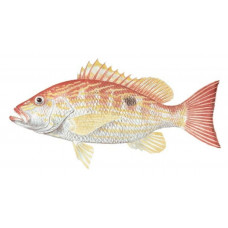Latin name
Lutjanus synagris
Other names
Portuguese: areocó; Spanish: bia-jaiba, chino, machego, pargo biajaiba, pargo guanapo, rayado, villajaiba.
Identification
Body is moderately high. The snout is pointed, and the lower jaw protrudes forward. Bases of soft parts of dorsal and anal fins covered by scales. The soft parts of the dorsal and anal fins are rounded. Lane snapper is silvery pink to reddish, with short, somewhat parallel pink and yellow stripes on the sides. A faint greenish tint is often present on the back and upper flanks, sometimes accentuated by several light olive stripes. Pectoral, pelvic and anal fins are frequently yellowish, and the dorsal and caudal fins are commonly reddish. The outer edge of the tail is black, especially toward the center. An eye-sized black spot is present just below the posterior dorsal fin and just above the lateral line, although it may be absent in rare cases. It is this spot that distinguishes the lane from other snapper, in addition to the anchor tooth on the roof of the mouth, the 18-22 gill rake on the first arch, and the round anal fin.
Distribution
In the tropical western Atlantic, they live from North Carolina to southeastern Brazil, including the Caribbean Sea and the Gulf of Mexico. They are often found in Florida and only occasionally in Bahamian and Caribbean waters.
Habitat
Bottom shelf fish. Dwelling in depths from 5 to 130 feet, lane snapper are found on all bottom types, although they prefer coral reefs and sandy areas with vegetation. Juveniles stay in the nearshore zone on grassy areas or shallow reefs, while adults move offshore where they explore deeper reefs. Occurring in both turbid and clear water, lancers often drift in whole flocks, especially during the breeding season. Occurs at depths of up to 400 m, but prefer a depth of less than 150 m. Adults do not enter brackish waters.
Size
Usually weighs less than a pound and is 8 to 12 inches long, sometimes reaching a maximum size of 15 inches. The world record for all tackle is considered to be a Mississippi fish weighing 8 pounds 3 ounces.
Life history and Behavior
Becoming sexually mature at the age of 1 year and 6-7 inches long, lane snapper spawn from March through September. Spawning activity peaks between June and August. Juveniles stay in the grassy thickets in estuaries that serve as feeding areas until they reach 5-6 inches in length, after which they migrate out to sea.
Food and feeding habits
Zoophage. Lane snapper are opportunistic predators and mainly consume food that is near or on the bottom, including anchovies and other small fish, crabs, shrimp, worms, and clams. They are fast enough to chase and capture their prey. They feed at night, moving off the reefs into the algae. As they grow, the proportion of fish in their diet increases.
Reproduction
Spawning takes place in portions. Off the coast of Cuba Island, it spawns at the edge of the shelf in March-October, with a peak in May-June. Each fish hatches 2-3 portions; spawning occurs during the full moon phase. The newly hatched eggs are 0.8 mm in diameter. Off the coast of Cuba Island, the average fecundity ranges from 126,800 eggs in two-year-olds to 1,474,300 eggs in nine-year-olds. The fecundity of fish off the coast of the Brazilian state of Сеара is 14-243 thousand, with an average of 89.5 thousand eggs.
| Classification | |
| Phylum | Chordata |
| Class | Actinopterygii |
| Squad | Perciformes |
| Family | Lutjanidae |
| Genus | Lutjanus |
| Species | L. synagris |
| Features | |
| Conservation status | Near Threatened |
| Habitat | Pelagic |
| Life span, years | No information |
| Maximum body weight, kg | 3.5 |
| Maximum length, cm | 60 |
| Sailing speed, m/s | No information |
| Threat to people | Edible |
| Way of eating | Predator |


